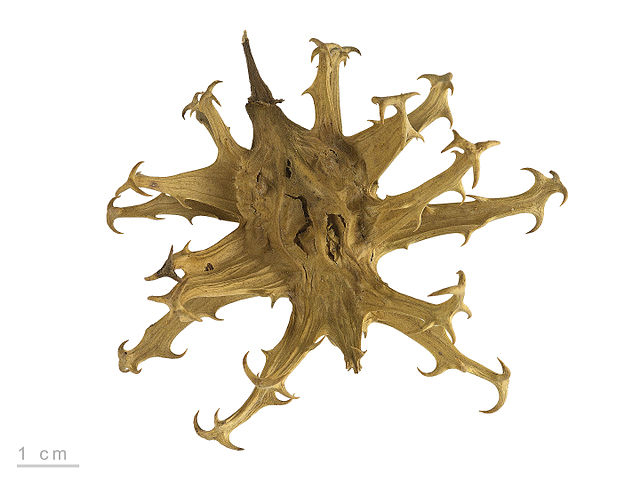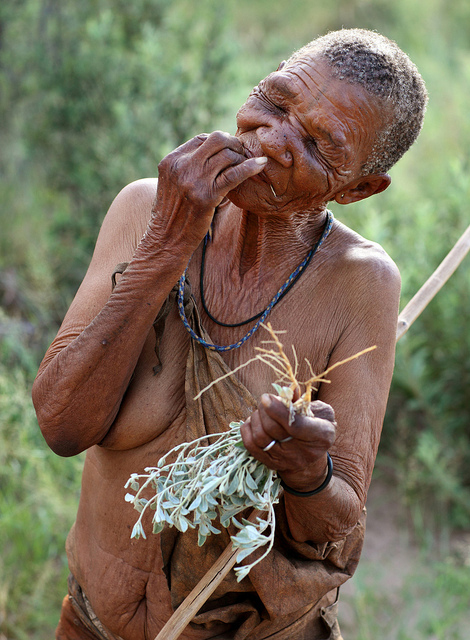A desert plant that grows in southern Africa with the intriguing popular name “devil’s claw” is being increasingly harvested by the Ju/’hoansi for sale on the international market. A news story in a Namibian newspaper last week provided an update on the increasing economic importance of the harvesting business. A report in this website in 2012 indicated that the devil’s claw roots must be harvested carefully and sustainably in order to be sold with the coveted certification of organic harvesting.

Devil’s claw, Harpagophytum procumbens, has been used for centuries, if not millennia, by the Ju/’hoansi and other dwellers of the Kalahari region to treat illnesses such as fevers, diseases of the digestive tract, skin problems, and various aches and pains. The name derives from the appearance of the fruits, which have strange little grappling hooks, or devil’s claws, protruding from them. The part that has been used medicinally by the indigenous Africans, and increasingly by international buyers, is derived from the tuberous roots of the plants.
A review article by L. Grant and others (2007) provides an overview of the uses of the herbal medicine. The authors examined many studies of the efficacy of the plant, and while some of them are inconclusive or contradictory, Grant and colleagues concluded that most of the evidence shows that the plant does, indeed, have effective anti-inflammatory and other important medicinal properties. Furthermore, the clinical trials reported in the scientific literature indicate that for the most part devil’s claw does alleviate pain and improve mobility for musculoskeletal conditions such as arthritis.

The exact ways it works are not clear, but its efficacy is generally accepted as scientific fact. Grant et al. point out that a German farmer who lived in Namibia in the 1920s learned about the medicinal value of devil’s claw tubers from the San people and sent samples back to Germany for analysis. As its benefits have become better known, it has been prepared by herbalists and marketed internationally, both as a tincture, as a dry extract, and as coated tablets.
So how do the Ju/’hoansi fit in? Lee (1979) pointed out that the people “are superb botanists and naturalists, with an intimate knowledge of their natural environment (p.158).” He wrote that they identified and had named over 200 different species of plants, of which over 100 were used as sources of food, the primary focus of his chapter. Devil’s claw was just one of the many plants that they used in their formerly nomadic, gathering and hunting existence.
By 2002, Biesele and Hitchcock (2013) reported, the collection and sale of devil’s claw tubers had grown into a small business for the Ju/’hoansi people, which generated an income of N$30,000, 1.5 percent of the income of the people in the Nyae Nyae Conservancy. Their book reported that five years later, in 2007, involvement of the people in harvesting devil’s claw tubers had grown a lot. In that year, 195 Ju/’hoansi individuals earned N$160,000 from the harvest of the devil’s claw. That year, the Nyae Nyae Conservancy also earned N$34,000 from the harvesting business.

The numbers continue to skyrocket. The Namibian article last week stated that in 2015, 575 people foraged in the desert surrounding their villages for the devil’s claw plants, which are an important part of the desert biodiversity, the journalist, Sirka Amaambo, wrote. The harvesters came from both the Nyae Nyae Conservancy and the N≠a Jaqna Conservancy immediately to the west of Nyae Nyae. N≠a Jaqna is the homeland of the! Kung San people who are closely related to the Ju/’hoansi. The residents of the two conservancies harvested 24 tons of organic devil’s claw tubers and earned N$800,000 (US$58,000) for themselves.
So far in 2016, 933 harvesters in 41 villages of the two conservancies are registered for gathering devil’s claw tubers. The income from the harvests are used to purchase household goods, clothing, and food.

The journalist interviewed a Ju/’hoan woman named /Ukxa, for her story. /Ukxa lives in the village of Makuri in Nyae Nyae and has been harvesting devil’s claw tubers for many years. She is in her late 60s, and her husband, Kaqece !Ui, is also an active harvester. She said that the harvesting is quite hard work, but, she said, “at least I will get something meaningful out of it.” Other elderly San people who persist in the harvesting work might say the same thing.
/Ukxa told Ms. Amaambo that even though she receives a pension from the state, it is not sufficient for all of the needs of herself and her family. “We are pleased that others can use this medicine,” she said about the devil’s claw she gathers, “but it is very important for us today, because unlike in the past, one needs money to get anything nowadays.”